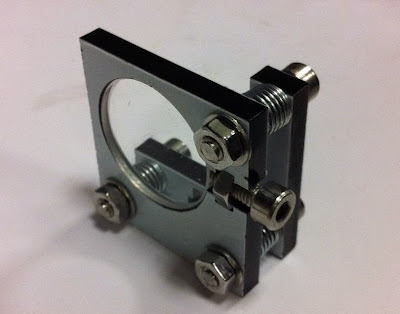The advantages of these laser cut mounts over 3d printed mounts are the speed at which you can make a mounts which is an order of magnitude faster and the cost (if you wanted to outsource making of them) is much lower with many different companies now providing low cost laser cutting. We have a CO2 laser cutter in the lab so we can make around ten of these in about 10-20 minutes. They are designed for 1 inch 25.4 mm optics such as lenses and mirrors and with the springs allow for adjustment and alignment of the optics.
A screw in the side holds the optic in place while the three bolts offset from the mounting plate allow for adjustment of the angle of the optic.
One big improvement would be to cut the same design out aluminium which would allow for a more rigid design so that more precise instruments could be constructed. Comparing the physical properties of different materials.
| Material | Coefficient of linear expansion (μm/(m K)) | Young's Modulus (MPa) |
|---|---|---|
| Acrylic | 75 | 3200 |
| Aluminium | 22.2 | 69000 |
| PET | 59.4 | 2700 |
| PLA | 80-90 | 1750 |
| ABS | 80 | 2200 |
Aluminum is optimal with a very high rigidity and low thermal coefficient of linear expansion. PET has a low coefficient but isn't as rigid as Acrylic. PLA and ABS both 3d printed materials lack rigidity and have high thermal coefficients. So for some applications acrylic optical mounts may provide high enough rigidity with low enough thermal expansion for some applications. However I can imagine some crosslinked epoxies could improve the properties of optical mounts made by 3d printers (quick search found a resin with Young's modulus of 2700)
I am currently working on using these in a spectrometer design. I will upload the designs soon for the optical mount and fixtures needed once I have refined the design a bit more.



wow nice model
ReplyDeleteCould you please send the files to make this to scientistnobee(at)gmail.com
ReplyDeletenice
ReplyDeleteHi, thank you so much for sharing this great idea. I tried to make a similar mount but the bolt is turning with the screw and I must adjust it every time. Is that sounds right?
ReplyDeleteYes it will turn with this design. I solved this by using hot glue to stop the nut from moving. The other option is to use two layers the first has a hole for the bolt the other has a cut out for the nut. My later blog post shows some of these designs. https://nznano.blogspot.com/2015/11/open-optics-talk-at-koala-2015.html Thanks for your interest!
Delete